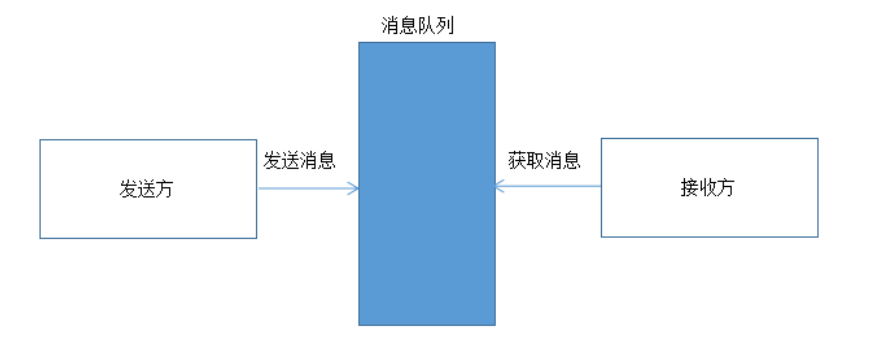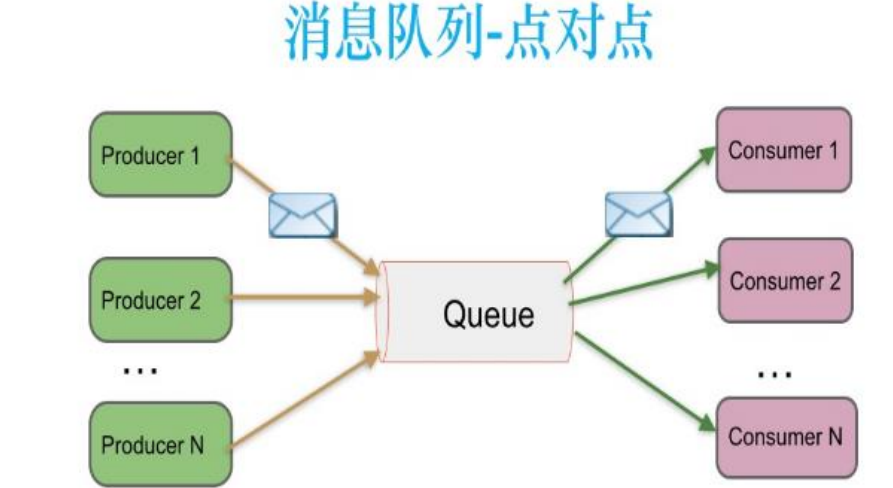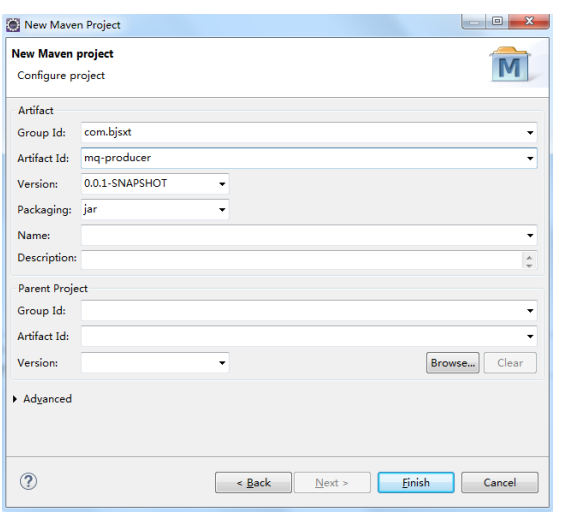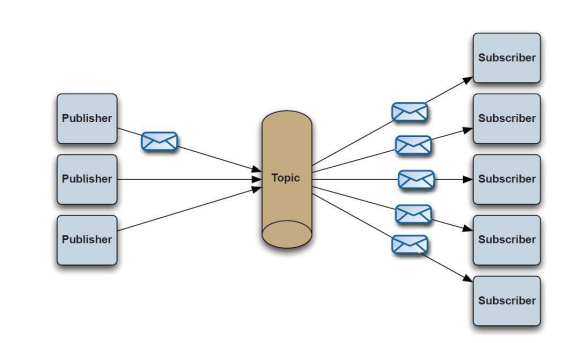ActiveMQ
一、 ActiveMQ 简介
1 什么是 ActiveMQ
ActiveMQ 是 Apache 出品,最流行的,能力强劲的开源消息总线。ActiveMQ 是一个
完全支持 JMS1.1 和 J2EE 1.4 规范的 JMS Provider 实现,尽管 JMS 规范出台已经是很久
的事情了,但是 JMS 在当今的 J2EE 应用中间仍然扮演着特殊的地位。
2 什么是消息
“消息”是在两台计算机间传送的数据单位。消息可以非常简单,例如只包含文本字符串;
也可以更复杂,可能包含嵌入对象。
3 什么是队列

4 什么是消息队列
“消息队列”是在消息的传输过程中保存消息的容器。
5 常用消息服务应用
5.1ActiveMQ
ActiveMQ 是 Apache 出品,最流行的,能力强劲的开源消息总线。ActiveMQ 是一个完
全支持 JMS1.1 和 J2EE 1.4 规范的 JMS Provider 实现。
5.2RabbitMQ
RabbitMQ 是一个在 AMQP 基础上完成的,可复用的企业消息系统。他遵循 Mozilla Public
License 开源协议。开发语言为 Erlang。
5.3RocketMQ
由阿里巴巴定义开发的一套消息队列应用服务。
二、 消息服务的应用场景
消息队列的主要特点是异步处理,主要目的是减少请求响应时间和解耦。所以主要的使
用场景就是将比较耗时而且不需要即时(同步)返回结果的操作作为消息放入消息队列。同
时由于使用了消息队列,只要保证消息格式不变,消息的发送方和接收方并不需要彼此联系,
也不需要受对方的影响,即解耦和。

5.1异步处理
5.1.1 用户注册
用户注册流程:
1)注册处理以及写数据库
2)发送注册成功的手机短信
3)发送注册成功的邮件信息
如果用消息中间件:则可以创建两个线程来做这些事情,直接发送消息给消息中间件,
然后让邮件服务和短信服务自己去消息中间件里面去取消息,然后取到消息后再自己做对应
的业务操作。就是这么方便
5.2应用的解耦
5.2.1 订单处理
生成订单流程:
1)在购物车中点击结算
2)完成支付
3)创建订单
4)调用库存系统
订单完成后,订单系统并不去直接调用库存系统,而是发送消息到消息中间件,写入一
个订单信息。库存系统自己去消息中间件上去获取,然后做发货处理,并更新库存,这样能
够实现互联网型应用追求的快这一个属性。而库存系统读取订单后库存应用这个操作也是非
常快的,所以有消息中间件对解耦来说也是一个不错的方向。
5.3流量的削峰
5.3.1 秒杀功能
秒杀流程:
1)用户点击秒杀
2)发送请求到秒杀应用
3)在请求秒杀应用之前将请求放入到消息队列
4)秒杀应用从消息队列中获取请求并处理。
比如,系统举行秒杀活动,热门商品。流量蜂拥而至 100 件商品,10 万人挤进来怎么
办?10 万秒杀的操作,放入消息队列。秒杀应用处理消息队列中的 10 万个请求中的前 100
个,其他的打回,通知失败。流量峰值控制在消息队列处,秒杀应用不会瞬间被怼死
三、 JMS
1 什么是 JMS
JMS(Java Messaging Service)是 Java 平台上有关面向消息中间件的技术规范,它便于
消息系统中的 Java 应用程序进行消息交换,并且通过提供标准的产生、发送、接收消息的接
口,简化企业应用的开发。
2 JMS 模型
2.1点对点模型(Point To Point)
生产者发送一条消息到 queue,只有一个消费者能收到

2.2发布订阅模型(Publish/Subscribe)
发布者发送到 topic 的消息,只有订阅了 topic 的订阅者才会收到消息

四、 ActiveMQ 安装
1 下载资源
ActiveMQ 官网: http://activemq.apache.org

1.1版本说明
ActiveMQ5.10.x 以上版本必须使用 JDK1.8 才能正常使用。
ActiveMQ5.9.x 及以下版本使用 JDK1.7 即可正常使用。
2 上传至 Linux 服务器
3 解压安装文件
tar -zxf apache-activemq-5.9.0-bin.tar.gz
4 检查权限
ls -al apache-activemq-5.9.0/bin
如果权限不足,则无法执行,需要修改文件权限:
chmod 755 activemq
5 复制应用至本地目录
cp -r apache-activemq-5.9.0 /usr/local/activemq
6 启动 ActiveMQ
/usr/local/activemq/bin/activemq start
7 测试 ActiveMQ
7.1检查进程
ps aux | grep activemq
见到下述内容即代表启动成功

7.2管理界面
使用浏览器访问 ActiveMQ 管理应用, 地址如下:
http://ip:8161/admin/
用户名: admin
密码: admin
ActiveMQ 使用的是 jetty 提供 HTTP 服务.启动稍慢,建议短暂等待再访问测试.
见到如下界面代表服务启动成功

7.3修改访问端口
修改 ActiveMQ 配置文件: /usr/local/activemq/conf/jetty.xml

配置文件修改完毕,保存并重新启动 ActiveMQ 服务。
7.4修改用户名和密码
修改 conf/users.properties 配置文件.内容为: 用户名=密码
保存并重启 ActiveMQ 服务即可.
8 重启 ActiveMQ
/usr/local/activemq/bin/activemq restart
9 关闭 ActiveMQ
/usr/local/activemq/bin/activemq stop
10 配置文件 activemq.xml
配置文件中,配置的是 ActiveMQ 的核心配置信息. 是提供服务时使用的配置. 可以修改
启动的访问端口. 即 java 编程中访问 ActiveMQ 的访问端口.
默认端口为 61616.
使用协议是: tcp 协议.
修改端口后, 保存并重启 ActiveMQ 服务即可.
11 ActiveMQ 目录介绍
从它的目录来说,还是很简单的:
* bin 存放的是脚本文件
* conf 存放的是基本配置文件
* data 存放的是日志文件
* docs 存放的是说明文档
* examples 存放的是简单的实例
* lib 存放的是 activemq 所需 jar 包
* webapps 用于存放项目的目录
五、 ActiveMQ 术语
1 Destination
目的地,JMS Provider(消息中间件)负责维护,用于对 Message 进行管理的对象。
MessageProducer 需要指定 Destination 才能发送消息,MessageReceiver 需要指定 Destination
才能接收消息。
2 Producer
消息生成者,负责发送 Message 到目的地。
3 Consumer | Receiver
消息消费者,负责从目的地中消费【处理|监听|订阅】Message。
4 Message
消息,消息封装一次通信的内容。
六、 ActiveMQ 应用
1 ActiveMQ 常用 API 简介
下述 API 都是接口类型,由定义在 javax.jms 包中.
是 JMS 标准接口定义.
1.1ConnectionFactory
链接工厂, 用于创建链接的工厂类型.
1.2Connection
链接. 用于建立访问 ActiveMQ 连接的类型, 由链接工厂创建.
1.3Session
会话, 一次持久有效有状态的访问. 由链接创建.
1.4Destination & Queue
目的地, 用于描述本次访问 ActiveMQ 的消息访问目的地. 即 ActiveMQ 服务中的具体队
列. 由会话创建.
interface Queue extends Destination
1.5MessageProducer
消息生成者, 在一次有效会话中, 用于发送消息给 ActiveMQ 服务的工具. 由会话创建.
1.6MessageConsumer
消息消费者【消息订阅者,消息处理者】, 在一次有效会话中, 用于从 ActiveMQ 服务中
获取消息的工具. 由会话创建.
1.7Message
消息, 通过消息生成者向 ActiveMQ 服务发送消息时使用的数据载体对象或消息消费者
从 ActiveMQ 服务中获取消息时使用的数据载体对象. 是所有消息【文本消息,对象消息等】
具体类型的顶级接口. 可以通过会话创建或通过会话从 ActiveMQ 服务中获取
.2 JMS-HelloWorld
2.1处理文本消息
2.1.1 创建消息生产者
2.1.1.1 创建工程

2.1.1.2 修改 POM 文件添加 ActiveMQ 坐标

<project xmlns="http://maven.apache.org/POM/4.0.0" xmlns:xsi="http://www.w3.org/2001/XMLSchema-instan ce" xsi:schemaLocation="http://maven.apache.org/POM/4. 0.0 http://maven.apache.org/xsd/maven-4.0.0.xsd"> <modelVersion>4.0.0</modelVersion> <groupId>com.bjsxt</groupId> <artifactId>mq-producer</artifactId> <version>0.0.1-SNAPSHOT</version> <dependencies> <!-- https://mvnrepository.com/artifact/org.apache.acti vemq/activemq-all --> <dependency> <groupId>org.apache.activemq</groupId> <artifactId>activemq-all</artifactId> <version>5.9.0</version> </dependency>
2.1.1.3 编写消息的生产者

public class HelloWorldProducer { /** * 生产消息 */ public void sendHelloWorldActiveMQ(String msgTest){ //定义链接工厂 ConnectionFactory connectionFactory = null; //定义链接对象 Connection connection = null; //定义会话 Session session = null; //目的地 Destination destination = null; //定义消息的发送者 MessageProducer producer = null; //定义消息 Message message = null; try{ /** * userName:访问 ActiveMQ 服务的用户名。用户 密码。默认的为 admin。用户名可以通过 jetty-ream.properties 文件进行修改 * password:访问 ActiveMQ 服务的用户名。用户 密码。默认的为 admin。用户名可以通过 jetty-ream.properties 文件进行修改 * brokerURL:访问 ActiveMQ 服务的路径地址。 路径结构为:协议名://主机地址:端口号 */ connectionFactory = new ActiveMQConnectionFactory("admin", "admin", "tcp://192.168.70.151:61616"); //创建连接对象 connection = connectionFactory.createConnection(); //启动连接 connection.start(); /** * transacted:是否使用事务 可选值为: true|false * true:使用事务 当设置次变量 值。Session.SESSION_TRANSACTED * false:不适用事务,设置次变量 则 acknowledgeMode 参数必须设置 * acknowledgeMode: * Session.AUTO_ACKNOWLEDGE:自动消息确认 机制 * Session.CLIENT_ACKNOWLEDGE:客户端确认 机制 * Session.DUPS_OK_ACKNOWLEDGE:有副本的客 户端确认消息机制 */ session = connection.createSession(false, Session.AUTO_ACKNOWLEDGE); //创建目的地,目的地名称即队列的名称。消息的 消费者需要通过此名称访问对应的队列 destination = session.createQueue("helloworld-destination"); //创建消息的生产者 producer = session.createProducer(destination); //创建消息对象 message = session.createTextMessage(msgTest); //发送消息 producer.send(message); }catch(Exception e){ e.printStackTrace(); }finally{ //回收消息发送者资源 if(producer != null){ try { producer.close(); } catch (JMSException e) { // TODO Auto-generated catch block e.printStackTrace(); } } if(session != null){ try { session.close(); } catch (JMSException e) { // TODO Auto-generated catch block e.printStackTrace(); } } if(connection != null){ try { connection.close(); } catch (JMSException e) { // TODO Auto-generated catch block e.printStackTrace(); } } } } }
2.1.2 创建消息消费者
2.1.2.1 创建工程

2.1.2.2 修改 POM 文件添加 ActiveMQ 坐标

<project xmlns="http://maven.apache.org/POM/4.0.0" xmlns:xsi="http://www.w3.org/2001/XMLSchema-instan ce" xsi:schemaLocation="http://maven.apache.org/P OM/4.0.0 http://maven.apache.org/xsd/maven-4.0.0.xsd"> <modelVersion>4.0.0</modelVersion> <groupId>com.bjsxt</groupId> <artifactId>mq-consumer</artifactId> <version>0.0.1-SNAPSHOT</version> <dependencies> <!-- https://mvnrepository.com/artifact/org.apache.acti vemq/activemq-all --> <dependency> <groupId>org.apache.activemq</groupId> <artifactId>activemq-all</artifactId> <version>5.9.0</version> </dependency> </dependencies> </project>
2.1.2.3 编写消息的消费者

public class HelloWorldConsumer { /** * 消费消息 */ public void readHelloWorldActiveMQ() { // 定义链接工厂 ConnectionFactory connectionFactory = null; // 定义链接对象 Connection connection = null; // 定义会话 Session session = null; // 目的地 Destination destination = null; // 定义消息的发送者 MessageConsumer consumer = null; // 定义消息 Message message = null; try { /** * userName:访问 ActiveMQ 服务的用户名。用户 密码。默认的为 admin。用户名可以通过 jetty-ream. * properties 文件进行修改 * password:访问 ActiveMQ 服务的用户名。用户 密码。默认的为 admin。用户名可以通过 jetty-ream. * properties 文件进行修改 brokerURL:访问 ActiveMQ 服务的路径地址。路径结构为:协议名://主机地址: 端口号 */ connectionFactory = new ActiveMQConnectionFactory("admin", "admin", "tcp://192.168.70.151:61616"); // 创建连接对象 connection = connectionFactory.createConnection(); // 启动连接 connection.start(); /** * transacted:是否使用事务 可选值为: true|false true:使用事务 * 当设置次变量值。 Session.SESSION_TRANSACTED false:不适用事务,设置次变 量 * 则 acknowledgeMode 参数必须设置 acknowledgeMode: * Session.AUTO_ACKNOWLEDGE:自动消息确认机 制 * Session.CLIENT_ACKNOWLEDGE:客户端确认 机制 * Session.DUPS_OK_ACKNOWLEDGE:有副本的客 户端确认消息机制 */ session = connection.createSession(false, Session.AUTO_ACKNOWLEDGE); // 创建目的地,目的地名称即队列的名称。消息 的消费者需要通过此名称访问对应的队列 destination = session.createQueue("helloworld-destination"); // 创建消息的消费者 consumer = session.createConsumer(destination); // 创建消息对象 message = consumer.receive(); //处理消息 String msg = ((TextMessage)message).getText(); System.out.println("从 ActiveMQ 服务中获取 的文本信息 "+msg); } catch (Exception e) { e.printStackTrace(); } finally { // 回收消息发送者资源 if (consumer != null) { try { consumer.close(); } catch (JMSException e) { // TODO Auto-generated catch block e.printStackTrace(); } } if (session != null) { try { session.close(); } catch (JMSException e) { // TODO Auto-generated catch block e.printStackTrace(); } } if (connection != null) { try { connection.close(); } catch (JMSException e) { // TODO Auto-generated catch block e.printStackTrace(); } } } } }
2.1.3 测试
2.1.3.1 Producer

public class Test { public static void main(String[] args) { HelloWorldProducer producer = new HelloWorldProducer(); producer.sendHelloWorldActiveMQ("HelloWorld"); } }
2.1.3.2 Consumer

public class Test { public static void main(String[] args) { HelloWorldConsumer consumer = new HelloWorldConsumer(); consumer.readHelloWorldActiveMQ(); } }
2.2处理对象消息
2.2.1 定义消息对象

public class Users implements Serializable{ private int userid; private String username; private int userage; public int getUserid() { return userid; } public void setUserid(int userid) { this.userid = userid; } public String getUsername() { return username; } public void setUsername(String username) { this.username = username; } public int getUserage() { return userage; } public void setUserage(int userage) { this.userage = userage; } @Override public String toString() { return "Users [userid=" + userid + ", username=" + username + ", userage=" + userage + "]"; } }
2.2.2 创建生产者

public class HelloWorldProducer2 { /** * 生产消息 */ public void sendHelloWorldActiveMQ(Users users){ //定义链接工厂 ConnectionFactory connectionFactory = null; //定义链接对象 Connection connection = null; //定义会话 Session session = null; //目的地 Destination destination = null; //定义消息的发送者 MessageProducer producer = null; //定义消息 Message message = null; try{ /** * userName:访问 ActiveMQ 服务的用户名。用户 密码。默认的为 admin。用户名可以通过 jetty-ream.properties 文件进行修改 * password:访问 ActiveMQ 服务的用户名。用户 密码。默认的为 admin。用户名可以通过 jetty-ream.properties 文件进行修改 * brokerURL:访问 ActiveMQ 服务的路径地址。 路径结构为:协议名://主机地址:端口号 */ connectionFactory = new ActiveMQConnectionFactory("admin", "admin", "tcp://192.168.70.151:61616"); //创建连接对象 connection = connectionFactory.createConnection(); //启动连接 connection.start(); /** * transacted:是否使用事务 可选值为: true|false * true:使用事务 当设置次变量值。 Session.SESSION_TRANSACTED * false:不适用事务,设置次变量 则 acknowledgeMode 参数必须设置 * acknowledgeMode: * Session.AUTO_ACKNOWLEDGE:自动消息确认机 制 * Session.CLIENT_ACKNOWLEDGE:客户端确认 机制 * Session.DUPS_OK_ACKNOWLEDGE:有副本的客 户端确认消息机制 */ session = connection.createSession(false, Session.AUTO_ACKNOWLEDGE); //创建目的地,目的地名称即队列的名称。消息的 消费者需要通过此名称访问对应的队列 destination = session.createQueue("my-users"); //创建消息的生产者 producer = session.createProducer(destination); //创建消息对象 message = session.createObjectMessage(users); //发送消息 producer.send(message); }catch(Exception e){ e.printStackTrace(); }finally{ //回收消息发送者资源 if(producer != null){ try { producer.close(); } catch (JMSException e) { // TODO Auto-generated catch block e.printStackTrace(); } } if(session != null){ try { session.close(); } catch (JMSException e) { // TODO Auto-generated catch block e.printStackTrace(); } } if(connection != null){ try { connection.close(); } catch (JMSException e) { // TODO Auto-generated catch block e.printStackTrace(); } } } } }
2.2.3 定义消息消费者

public class HelloWorldConsumer2 { /** * 消费消息 */ public void readHelloWorldActiveMQ() { // 定义链接工厂 ConnectionFactory connectionFactory = null; // 定义链接对象 Connection connection = null; // 定义会话 Session session = null; // 目的地 Destination destination = null; // 定义消息的发送者 MessageConsumer consumer = null; // 定义消息 Message message = null; try { /** * userName:访问 ActiveMQ 服务的用户名。用户 密码。默认的为 admin。用户名可以通过 jetty-ream. * properties 文件进行修改 * password:访问 ActiveMQ 服务的用户名。用户 密码。默认的为 admin。用户名可以通过 jetty-ream. * properties 文件进行修改 brokerURL:访问 ActiveMQ 服务的路径地址。路径结构为:协议名://主机地址: 端口号 */ connectionFactory = new ActiveMQConnectionFactory("admin", "admin", "tcp://192.168.70.151:61616"); // 创建连接对象 connection = connectionFactory.createConnection(); // 启动连接 connection.start(); /** * transacted:是否使用事务 可选值为: true|false true:使用事务 * 当设置次变量值。 Session.SESSION_TRANSACTED false:不适用事务,设置次变 量 * 则 acknowledgeMode 参数必须设置 acknowledgeMode: * Session.AUTO_ACKNOWLEDGE:自动消息确认机 制 * Session.CLIENT_ACKNOWLEDGE:客户端确认 机制 * Session.DUPS_OK_ACKNOWLEDGE:有副本的客 户端确认消息机制 */ session = connection.createSession(false, Session.AUTO_ACKNOWLEDGE); // 创建目的地,目的地名称即队列的名称。消息 的消费者需要通过此名称访问对应的队列 destination = session.createQueue("my-users"); // 创建消息的消费者 consumer = session.createConsumer(destination); // 创建消息对象 message = consumer.receive(); //处理消息 ObjectMessage objMessage = (ObjectMessage)message; Users users = (Users)objMessage.getObject(); System.out.println(users); } catch (Exception e) { e.printStackTrace(); } finally { // 回收消息发送者资源 if (consumer != null) { try { consumer.close(); } catch (JMSException e) { // TODO Auto-generated catch block e.printStackTrace(); } } if (session != null) { try { session.close(); } catch (JMSException e) { // TODO Auto-generated catch block e.printStackTrace(); } } if (connection != null) { try { connection.close(); } catch (JMSException e) { // TODO Auto-generated catch block e.printStackTrace(); } } } } }
3 JMS - 实现队列服务监听
队列服务监听使用的观察者设计模式
3.1创建消息生产者

public class HelloWorldProducer3 { /** * 生产消息 */ public void sendHelloWorldActiveMQ(String msgTest){ //定义链接工厂 ConnectionFactory connectionFactory = null; //定义链接对象 Connection connection = null; //定义会话 Session session = null; //目的地 Destination destination = null; //定义消息的发送者 MessageProducer producer = null; //定义消息 Message message = null; try{ /** * userName:访问 ActiveMQ 服务的用户名。用户 密码。默认的为 admin。用户名可以通过 jetty-ream.properties 文件进行修改 * password:访问 ActiveMQ 服务的用户名。用户 密码。默认的为 admin。用户名可以通过 jetty-ream.properties 文件进行修改 * brokerURL:访问 ActiveMQ 服务的路径地址。 路径结构为:协议名://主机地址:端口号 */ connectionFactory = new ActiveMQConnectionFactory("admin", "admin", "tcp://192.168.70.151:61616"); //创建连接对象 connection = connectionFactory.createConnection(); //启动连接 connection.start(); /** * transacted:是否使用事务 可选值为: true|false * true:使用事务 当设置次变量值。 Session.SESSION_TRANSACTED * false:不适用事务,设置次变量 则 acknowledgeMode 参数必须设置 * acknowledgeMode: * Session.AUTO_ACKNOWLEDGE:自动消息确认机 制 * Session.CLIENT_ACKNOWLEDGE:客户端确认 机制 * Session.DUPS_OK_ACKNOWLEDGE:有副本的客 户端确认消息机制 */ session = connection.createSession(false, Session.AUTO_ACKNOWLEDGE); //创建目的地,目的地名称即队列的名称。消息的 消费者需要通过此名称访问对应的队列 destination = session.createQueue("my-destination"); //创建消息的生产者 producer = session.createProducer(destination); //创建消息对象 message = session.createTextMessage(msgTest); //发送消息 producer.send(message); }catch(Exception e){ e.printStackTrace(); }finally{ //回收消息发送者资源 if(producer != null){ try { producer.close(); } catch (JMSException e) { // TODO Auto-generated catch block e.printStackTrace(); } } if(session != null){ try { session.close(); } catch (JMSException e) { // TODO Auto-generated catch block e.printStackTrace(); } } if(connection != null){ try { connection.close(); } catch (JMSException e) { // TODO Auto-generated catch block e.printStackTrace(); } } } } }
3.2消息消费者

public class HelloWorldConsumer3 { /** * 消费消息 */ public void readHelloWorldActiveMQ() { // 定义链接工厂 ConnectionFactory connectionFactory = null; // 定义链接对象 Connection connection = null; // 定义会话 Session session = null; // 目的地 Destination destination = null; // 定义消息的发送者 MessageConsumer consumer = null; // 定义消息 Message message = null; try { /** * userName:访问 ActiveMQ 服务的用户名。用户 密码。默认的为 admin。用户名可以通过 jetty-ream. * properties 文件进行修改 * password:访问 ActiveMQ 服务的用户名。用户 密码。默认的为 admin。用户名可以通过 jetty-ream. * properties 文件进行修改 brokerURL:访问 ActiveMQ 服务的路径地址。路径结构为:协议名://主机地址: 端口号 */ connectionFactory = new ActiveMQConnectionFactory("admin", "admin", "tcp://192.168.70.151:61616"); // 创建连接对象 connection = connectionFactory.createConnection(); // 启动连接 connection.start(); /** * transacted:是否使用事务 可选值为: true|false true:使用事务 * 当设置次变量值。 Session.SESSION_TRANSACTED false:不适用事务,设置次变 量 * 则 acknowledgeMode 参数必须设置 acknowledgeMode: * Session.AUTO_ACKNOWLEDGE:自动消息确认机 制 * Session.CLIENT_ACKNOWLEDGE:客户端确认 机制 * Session.DUPS_OK_ACKNOWLEDGE:有副本的客 户端确认消息机制 */ session = connection.createSession(false, Session.AUTO_ACKNOWLEDGE); // 创建目的地,目的地名称即队列的名称。消息 的消费者需要通过此名称访问对应的队列 destination = session.createQueue("my-destination"); // 创建消息的消费者 consumer = session.createConsumer(destination); consumer.setMessageListener(new MessageListener() { //ActiveMQ 回调的方法。通过该方法将消息传 递到 consumer @Override public void onMessage(Message message) { //处理消息 String msg=null; try { msg = ((TextMessage)message).getText(); } catch (JMSException e) { // TODO Auto-generated catch block e.printStackTrace(); } System.out.println("从 ActiveMQ 服务 中获取的文本信息 "+msg); } }); } catch (Exception e) { e.printStackTrace(); } } }
4 Topic 模型
4.1Publish/Subscribe 处理模式(Topic)
消息生产者(发布)将消息发布到 topic 中,同时有多个消息消费者(订阅)消费该消息。
和点对点方式不同,发布到 topic 的消息会被所有订阅者消费。
当生产者发布消息,不管是否有消费者。都不会保存消息
一定要先有消息的消费者,后有消息的生产者。

4.2创建生产者

public class HelloWorldProducerTopic { /** * 生产消息 */ public void sendHelloWorldActiveMQ(String msgTest){ //定义链接工厂 ConnectionFactory connectionFactory = null; //定义链接对象 Connection connection = null; //定义会话 Session session = null; //目的地 Destination destination = null; //定义消息的发送者 MessageProducer producer = null; //定义消息 Message message = null; try{ /** * userName:访问 ActiveMQ 服务的用户名。用户 密码。默认的为 admin。用户名可以通过 jetty-ream.properties 文件进行修改 * password:访问 ActiveMQ 服务的用户名。用户 密码。默认的为 admin。用户名可以通过 jetty-ream.properties 文件进行修改 * brokerURL:访问 ActiveMQ 服务的路径地址。 路径结构为:协议名://主机地址:端口号 */ connectionFactory = new ActiveMQConnectionFactory("admin", "admin", "tcp://192.168.70.151:61616"); //创建连接对象 connection = connectionFactory.createConnection(); //启动连接 connection.start(); /** * transacted:是否使用事务 可选值为: true|false * true:使用事务 当设置次变量值。 Session.SESSION_TRANSACTED * false:不适用事务,设置次变量 则 acknowledgeMode 参数必须设置 * acknowledgeMode: * Session.AUTO_ACKNOWLEDGE:自动消息确认机 制 * Session.CLIENT_ACKNOWLEDGE:客户端确认 机制 * Session.DUPS_OK_ACKNOWLEDGE:有副本的客 户端确认消息机制 */ session = connection.createSession(false, Session.AUTO_ACKNOWLEDGE); //创建目的地,目的地名称即队列的名称。消息的 消费者需要通过此名称访问对应的队列 destination = session.createTopic("test-topic"); //创建消息的生产者 producer = session.createProducer(destination); //创建消息对象 message = session.createTextMessage(msgTest); //发送消息 producer.send(message); }catch(Exception e){ e.printStackTrace(); }finally{ //回收消息发送者资源 if(producer != null){ try { producer.close(); } catch (JMSException e) { // TODO Auto-generated catch block e.printStackTrace(); } } if(session != null){ try { session.close(); } catch (JMSException e) { // TODO Auto-generated catch block e.printStackTrace(); } } if(connection != null){ try { connection.close(); } catch (JMSException e) { // TODO Auto-generated catch block e.printStackTrace(); } } } } }
4.3创建消费者

public class HelloWorldConsumerTopic1 implements Runnable{ /** * 消费消息 */ public void readHelloWorldActiveMQ() { // 定义链接工厂 ConnectionFactory connectionFactory = null; // 定义链接对象 Connection connection = null; // 定义会话 Session session = null; // 目的地 Destination destination = null; // 定义消息的发送者 MessageConsumer consumer = null; // 定义消息 Message message = null; try { /** * userName:访问 ActiveMQ 服务的用户名。用户 密码。默认的为 admin。用户名可以通过 jetty-ream. * properties 文件进行修改 * password:访问 ActiveMQ 服务的用户名。用户 密码。默认的为 admin。用户名可以通过 jetty-ream. * properties 文件进行修改 brokerURL:访问 ActiveMQ 服务的路径地址。路径结构为:协议名://主机地址: 端口号 */ connectionFactory = new ActiveMQConnectionFactory("admin", "admin", "tcp://192.168.70.151:61616"); // 创建连接对象 connection = connectionFactory.createConnection(); // 启动连接 connection.start(); /** * transacted:是否使用事务 可选值为: true|false true:使用事务 * 当设置次变量值。 Session.SESSION_TRANSACTED false:不适用事务,设置次变 量 * 则 acknowledgeMode 参数必须设置 acknowledgeMode: * Session.AUTO_ACKNOWLEDGE:自动消息确认机 制 * Session.CLIENT_ACKNOWLEDGE:客户端确认 机制 * Session.DUPS_OK_ACKNOWLEDGE:有副本的客 户端确认消息机制 */ session = connection.createSession(false, Session.AUTO_ACKNOWLEDGE); // 创建目的地,目的地名称即队列的名称。消息 的消费者需要通过此名称访问对应的队列 destination = session.createTopic("test-topic"); // 创建消息的消费者 consumer = session.createConsumer(destination); consumer.setMessageListener(new MessageListener() { //ActiveMQ 回调的方法。通过该方法将消息传 递到 consumer @Override public void onMessage(Message message) { //处理消息 String msg=null; try { msg = ((TextMessage)message).getText(); } catch (JMSException e) { // TODO Auto-generated catch block e.printStackTrace(); } System.out.println("从 ActiveMQ 服务 中获取的文本信息 ---topic1 "+msg); } }); } catch (Exception e) { e.printStackTrace(); } } @Override public void run() { this.readHelloWorldActiveMQ(); } }
七、 Spring 整合 ActiveMQ
1 创建 spring-activemq-producer
1.1修改 POM 文件

<project xmlns="http://maven.apache.org/POM/4.0.0" xmlns:xsi="http://www.w3.org/2001/XMLSchema-instan ce" xsi:schemaLocation="http://maven.apache.org/P OM/4.0.0 http://maven.apache.org/xsd/maven-4.0.0.xsd"> <modelVersion>4.0.0</modelVersion> <parent> <groupId>com.bjsxt</groupId> <artifactId>parent</artifactId> <version>0.0.1-SNAPSHOT</version> </parent> <groupId>com.bjsxt</groupId> <artifactId>spring-activemq-producer</artifac tId> <version>0.0.1-SNAPSHOT</version> <packaging>war</packaging> <dependencies> <!-- ActiveMQ 客户端完整 jar 包依赖 --> <dependency> <groupId>org.apache.activemq</groupId> <artifactId>activemq-all</artifactId> </dependency> <!-- ActiveMQ 和 Spring 整合配置文件标签处理 jar 包依赖 --> <dependency> <groupId>org.apache.xbean</groupId> <artifactId>xbean-spring</artifactId> </dependency> <!-- Spring-JMS 插件相关 jar 包依赖 --> <dependency> <groupId>org.springframework</groupId> <artifactId>spring-jms</artifactId> </dependency> <!-- 单元测试 --> <dependency> <groupId>junit</groupId> <artifactId>junit</artifactId> </dependency> <!-- 日志处理 --> <dependency> <groupId>org.slf4j</groupId> <artifactId>slf4j-log4j12</artifactId> </dependency> <!-- spring --> <dependency> <groupId>org.springframework</groupId> <artifactId>spring-context</artifactId> </dependency> <dependency> <groupId>org.springframework</groupId> <artifactId>spring-beans</artifactId> </dependency> <dependency> <groupId>org.springframework</groupId> <artifactId>spring-webmvc</artifactId> </dependency> <!-- JSP 相关 --> <dependency> <groupId>jstl</groupId> <artifactId>jstl</artifactId> </dependency> <dependency> <groupId>javax.servlet</groupId> <artifactId>servlet-api</artifactId> <scope>provided</scope> </dependency> <dependency> <groupId>javax.servlet</groupId> <artifactId>jsp-api</artifactId> <scope>provided</scope> </dependency> </dependencies> <build> <plugins> <!-- 配置 Tomcat 插件 --> <plugin> <groupId>org.apache.tomcat.maven</groupId> <artifactId>tomcat7-maven-plugin</artifactId> <configuration> <path>/</path> <port>8080</port> </configuration> </plugin> </plugins> </build> </project>
1.2整合 ActiveMQ

<?xml version="1.0" encoding="UTF-8"?> <beans xmlns="http://www.springframework.org/schema/beans " xmlns:xsi="http://www.w3.org/2001/XMLSchema-i nstance" xmlns:jms="http://www.springframework.org/sch ema/jms" xmlns:context="http://www.springframework.org /schema/context" xmlns:amq="http://activemq.apache.org/schema/ core" xsi:schemaLocation=" http://www.springframework.org/schema/beans http://www.springframework.org/schema/beans/spr ing-beans.xsd http://www.springframework.org/schema/jms http://www.springframework.org/schema/jms/sprin g-jms.xsd http://activemq.apache.org/schema/core http://activemq.apache.org/schema/core/activemq -core.xsd http://www.springframework.org/schema/context http://www.springframework.org/schema/context/s pring-context.xsd"> <!-- 需要创建一个连接工厂,连接 ActiveMQ. ActiveMQConnectionFactory. 需要依赖 ActiveMQ 提供的 amq 标签 --> <!-- amq:connectionFactory 是 bean 标签的子标签, 会在 spring 容器中创建一个 bean 对象. 可以为对象命名. 类似: <bean id="" class="ActiveMQConnectionFactory"></bean> --> <amq:connectionFactory brokerURL="tcp://192.168.70.151:61616" userName="admin" password="admin" id="amqConnectionFactory"/> <!-- spring 管理 JMS 相关代码的时候,必须依赖 jms 标 签库. spring-jms 提供的标签库. --> <!-- 定义 Spring-JMS 中的连接工厂对象 CachingConnectionFactory - spring 框架提供的 连接工厂对象. 不能真正的访问 MOM 容器. 类似一个工厂的代理对象. 需要提供一个真实工 厂,实现 MOM 容器的连接访问. --> <bean id="pooledConnectionFactory" class="org.apache.activemq.pool.PooledConnectio nFactoryBean"> <property name="connectionFactory" ref="amqConnectionFactory"></property> <property name="maxConnections" value="10"></property> </bean> <!-- 配置有缓存的 ConnectionFactory,session 的 缓存大小可定制。 --> <bean id="connectionFactory" class="org.springframework.jms.connection.Cachi ngConnectionFactory"> <property name="targetConnectionFactory" ref="pooledConnectionFactory"></property> <property name="sessionCacheSize" value="3"></property> </bean> <!-- JmsTemplate 配置 --> <bean id="template" class="org.springframework.jms.core.JmsTemplate"> <!-- 给定连接工厂, 必须是 spring 创建的连接工 厂. --> <property name="connectionFactory" ref="connectionFactory"></property> <!-- 可选 - 默认目的地命名 --> <property name="defaultDestinationName" value="test-spring"></property> </bean> </beans>
2 创建 spring-activemq-consumer
是一个 jar 工程
2.1修改 POM 文件

<project xmlns="http://maven.apache.org/POM/4.0.0" xmlns:xsi="http://www.w3.org/2001/XMLSchema-instan ce" xsi:schemaLocation="http://maven.apache.org/POM/4. 0.0 http://maven.apache.org/xsd/maven-4.0.0.xsd"> <modelVersion>4.0.0</modelVersion> <parent> <groupId>com.bjsxt</groupId> <artifactId>parent</artifactId> <version>0.0.1-SNAPSHOT</version> </parent> <groupId>com.bjsxt</groupId> <artifactId>spring-activemq-consumer</artifactId> <version>0.0.1-SNAPSHOT</version> <dependencies> <!-- activemq 客户端 --> <dependency> <groupId>org.apache.activemq</groupId> <artifactId>activemq-all</artifactId> </dependency> <!-- spring 框架对 JMS 标准的支持 --> <dependency> <groupId>org.springframework</groupId> <artifactId>spring-jms</artifactId> </dependency> <!-- ActiveMQ 和 spring 整合的插件 --> <dependency> <groupId>org.apache.xbean</groupId> <artifactId>xbean-spring</artifactId> </dependency> <dependency> <groupId>org.springframework</groupId> <artifactId>spring-context</artifactId> </dependency> <dependency> <groupId>org.springframework</groupId> <artifactId>spring-beans</artifactId> </dependency> </dependencies> </project>
2.2整合 ActiveMQ

<?xml version="1.0" encoding="UTF-8"?> <beans xmlns="http://www.springframework.org/schema/beans " xmlns:xsi="http://www.w3.org/2001/XMLSchema-i nstance" xmlns:jms="http://www.springframework.org/sch ema/jms" xmlns:amq="http://activemq.apache.org/schema/ core" xsi:schemaLocation=" http://www.springframework.org/schema/beans http://www.springframework.org/schema/beans/spr ing-beans.xsd http://www.springframework.org/schema/jms http://www.springframework.org/schema/jms/sprin g-jms.xsd http://activemq.apache.org/schema/core http://activemq.apache.org/schema/core/activemq -core.xsd"> <!-- 需要创建一个连接工厂,连接 ActiveMQ. ActiveMQConnectionFactory. 需要依赖 ActiveMQ 提供的 amq 标签 --> <!-- amq:connectionFactory 是 bean 标签的子标签, 会在 spring 容器中创建一个 bean 对象. 可以为对象命名. 类似: <bean id="" class="ActiveMQConnectionFactory"></bean> --> <amq:connectionFactory brokerURL="tcp://192.168.70.151:61616" userName="admin" password="admin" id="amqConnectionFactory"/> <!-- spring 管理 JMS 相关代码的时候,必须依赖 jms 标 签库. spring-jms 提供的标签库. --> <!-- 定义 Spring-JMS 中的连接工厂对象 CachingConnectionFactory - spring 框架提供的 连接工厂对象. 不能真正的访问 MOM 容器. 类似一个工厂的代理对象. 需要提供一个真实工 厂,实现 MOM 容器的连接访问. --> <bean id="connectionFactory" class="org.springframework.jms.connection.Cachi ngConnectionFactory"> <property name="targetConnectionFactory" ref="amqConnectionFactory"></property> <property name="sessionCacheSize" value="3"></property> </bean> <!-- 注册监听器 --> <!-- 开始注册监听. 需要的参数有: acknowledge - 消息确认机制 container-type - 容器类型 default|simple simple:SimpleMessageListenerContainer 最 简单的消息监听器容器,只能处理固定数量的 JMS 会话,且不支 持事务。 default:DefaultMessageListenerContainer 是一个用于异步消息监听器容器 ,且支持事务 destination-type - 目的地类型. 使用队列作 为目的地. connection-factory - 连接工厂, spring-jms 使用的连接工厂,必须是 spring 自主创建的 不能使用三方工具创建的工程. 如: ActiveMQConnectionFactory. --> <jms:listener-container acknowledge="auto" container-type="default" destination-type="queue" connection-factory="connectionFactory" > <!-- 在监听器容器中注册某监听器对象. destination - 设置目的地命名 ref - 指定监听器对象 --> <jms:listener destination="test-spring" ref="myListener"/> </jms:listener-container> </beans>
3 测试整合
需求:
1)在 producer 中创建 Users 对象
2)将 Users 对象传递到 ActiveMQ 中
3)在 Consumer 中获取 Users 对象并在控制台打印
3.1Producer 发送消息
3.1.1 如果使用了连接池需要添加两个坐标
PooledConnectionFactoryBean

<dependency> <groupId>org.apache.activemq</groupId> <artifactId>activemq-pool</artifactId> <version>5.9.0</version> </dependency> <dependency> <groupId>org.apache.activemq</groupId> <artifactId>activemq-jms-pool</artifactId> <version>5.9.0</version> </dependency>
3.1.2 发送消息

@Service public class UserServiceImpl implements UserService { @Autowired private JmsTemplate jmsTemplate; @Override public void addUser(final Users user) { //发送消息 this.jmsTemplate.send(new MessageCreator() { @Override public Message createMessage(Session session) throws JMSException { Message message = session.createObjectMessage(user); return message; } }); } }
3.2Consumer 接收消息
3.2.1 接收消息

@Component(value="myListener") public class MyMessageListener implements MessageListener{ @Autowired private UserService userService; @Override public void onMessage(Message message) { //处理消息 ObjectMessage objMessage = (ObjectMessage)message; Users user=null; try { user = (Users)objMessage.getObject(); } catch (JMSException e) { // TODO Auto-generated catch block e.printStackTrace(); } this.userService.showUser(user); } }
